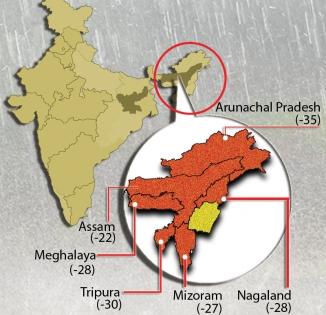NE states, especially Assam and Arunachal, receive deficient rain
By IANS | Published: July 26, 2021 09:34 PM2021-07-26T21:34:10+5:302021-07-26T21:45:31+5:30
New Delhi, July 26 Even when several parts of India are overwhelmed with excessive rainfall and massive flooding, ...

NE states, especially Assam and Arunachal, receive deficient rain
New Delhi, July 26 Even when several parts of India are overwhelmed with excessive rainfall and massive flooding, the northeastern states, especially Arunachal Pradesh and Assam, received deficient rainfall in June and till the third week of July.
Data from the India Meteorological Department (IMD) shows that as on Monday, July 26, the subdivision of Assam and Meghalaya has shown deficient rainfall with departure of -24 per cent; Arunachal Pradesh has shown a departure of -35 per cent, while the NMMT (Nagaland, Mizoram, Manipur and Tripura) subdivision has witnessed a departure of -36 per cent.
State-wise, Arunachal Pradesh leads with -35 per cent, followed by Tripura at -30 per cent, Nagaland and Meghalaya at -28 per cent each, Mizoram at -27 per cent and Assam the least at -22 per cent departure from normal rainfall, which is based on long period average rainfall from 1961 to 2010.
In IMD parlance, -19 per cent to +19 per cent is Normal rainfall; -59 per cent to -20 per cent is considered Deficient rainfall; -90 per cent to -60 per cent is Large Deficient rainfall; 20 per cent to 59 per cent is Excess rainfall; and 60 per cent or more is Large Excess rainfall.
If we consider IMD data from 2000 onwards for the entire northeast region, the year 2018 witnessed deficient rainfall both in June and July (-26.3 per cent and -23.4 per cent, respectively); 2016 saw deficient rainfall in June (-24.1 per cent); 2014 saw deficient rainfall in both June (-20.8 per cent) and July (-24.5 per cent); 2013 too witnessed deficient rainfall in both June (-30.5 per cent) and July (-33.9 per cent); 2010 saw deficient rainfall in July (-26.6 per cent); 2009 saw deficient rainfall in both June (-49.1 per cent) and July (-24.5 per cent); while a major deficient rainfall was witnessed in June 2005 (-40.1 per cent).
"Whenever monsoon will be active in the country as a whole, meaning peninsular India and central India getting good rainfall, northeastern states will get less rainfall. It is just like a mirror image. When northeast India gets good rains, central India will get less rains," IMD Director General (Meteorology) Mrutyunjay Mohapatra told .
Indeed, large parts of central India, including the Konkan coastal areas, Madhya Pradesh and some parts of Vidarbha, have seen rains play havoc over the last week, causing much devastations due to flooding and landslides.
Further explaining the scientific reasoning, Mohapatra said, "When central and peninsular India are getting good rains, monsoon trough is to the south of its normal position. Hence, the monsoon winds do not reach the northeastern states. But when the monsoon trough shifts to the foothills of the Himalayas, winds become southerly (from south), i.e., from Bay of Bengal towards northeastern states. Therefore, the northeast region gets very good rains."
According to the IMD, 'monsoon trough' is an elongated low-pressure area which extends from heat low over Pakistan to head Bay of Bengal. This is one of semi-permanent feature of monsoon circulation. Monsoon trough may be a characteristic of east-west orientation of Himalayan ranges and north-south orientation of the Khasi-Jaintia Hills in the northeast.
During the northward march of sun in the northern hemisphere, the continent surrounding the Arabian Sea begin to receive large amounts of heat; not only in the form of radiation from sun, but also flux of heat from the earth's surface into the atmosphere (160 Watts/m2 for the month of June over the arid zones of northwest India, Pakistan and Middle Eastern countries). As a result of this, large input of power, and trough of low pressure form over this region, as per the IMD.
The IMD has divided the northeast region into seven sub-divisions. Of these, especially Assam and Arunachal Pradesh are showing deficient rainfall more than the others.
Generally, the eastern side of monsoon trough oscillates, sometimes southwards and sometimes northwards. Southward migration results in active/vigorous monsoon over major parts of India.
In contrast, the northward migration of this trough leads to break monsoon condition over major parts of India and heavy rains along the foothills of Himalayas and sometimes floods in river Brahmaputra, an IMD official explained.
The IMD had come out with a rainfall variability study for all the states wherein all the analysis of observed rainfall patterns, trends and variability was done based on data of the past 30 years (1989-2018).
For Arunachal Pradesh, only June and annual rainfall shows significant decreasing trend while rest of the months and seasonal rainfall did not show any significant increasing/decreasing trend. All the months, along with seasonal and annual rainfall, showed decreasing trend, the report said.
For Assam, the report mentioned that neither monthly rainfall nor seasonal or annual rainfall showed any significant increasing/decreasing trend. In the monthly rainfall, all months from June-September showed slight decreasing trend. Both seasonal and annual rainfall also showed slight decreasing trend, it said.
Disclaimer: This post has been auto-published from an agency feed without any modifications to the text and has not been reviewed by an editor
Open in app